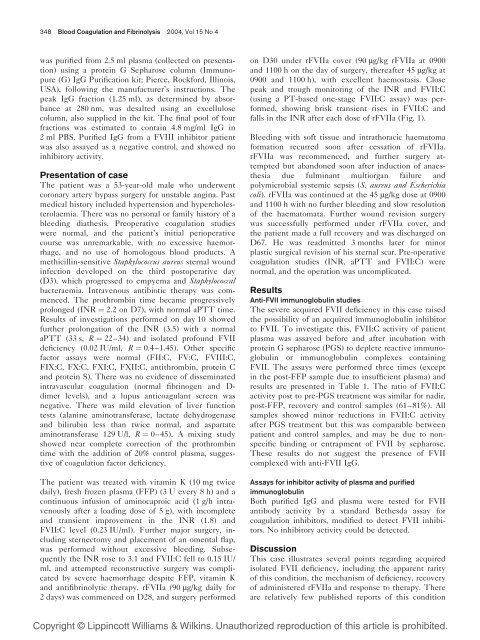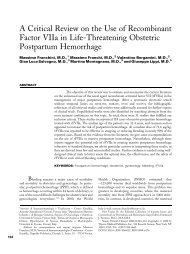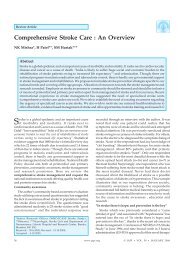Acquired isolated factor VII deficiency associated with severe ...
Acquired isolated factor VII deficiency associated with severe ...
Acquired isolated factor VII deficiency associated with severe ...
Create successful ePaper yourself
Turn your PDF publications into a flip-book with our unique Google optimized e-Paper software.
348 Blood Coagulation and Fibrinolysis 2004, Vol 15 No 4<br />
was purified from 2.5 ml plasma (collected on presentation)<br />
using a protein G Sepharose column (Immunopure<br />
(G) IgG Purification kit; Pierce, Rockford, Illinois,<br />
USA), following the manufacturer’s instructions. The<br />
peak IgG fraction (1.25 ml), as determined by absorbance<br />
at 280 nm, was desalted using an excellulose<br />
column, also supplied in the kit. The final pool of four<br />
fractions was estimated to contain 4.8 mg/ml IgG in<br />
2 ml PBS. Purified IgG from a F<strong>VII</strong>I inhibitor patient<br />
was also assayed as a negative control, and showed no<br />
inhibitory activity.<br />
Presentation of case<br />
The patient was a 53-year-old male who underwent<br />
coronary artery bypass surgery for unstable angina. Past<br />
medical history included hypertension and hypercholesterolaemia.<br />
There was no personal or family history of a<br />
bleeding diathesis. Preoperative coagulation studies<br />
were normal, and the patient’s initial perioperative<br />
course was unremarkable, <strong>with</strong> no excessive haemorrhage,<br />
and no use of homologous blood products. A<br />
methicillin-sensitive Staphylococcus aureus sternal wound<br />
infection developed on the third postoperative day<br />
(D3), which progressed to empyema and Staphylococcal<br />
bacteraemia. Intravenous antibiotic therapy was commenced.<br />
The prothrombin time became progressively<br />
prolonged (INR ¼ 2.2 on D7), <strong>with</strong> normal aPTT time.<br />
Results of investigations performed on day 10 showed<br />
further prolongation of the INR (3.5) <strong>with</strong> a normal<br />
aPTT (33 s, R ¼ 22–34) and <strong>isolated</strong> profound F<strong>VII</strong><br />
<strong>deficiency</strong> (0.02 IU/ml, R ¼ 0.4–1.45). Other specific<br />
<strong>factor</strong> assays were normal (FII:C, FV:C, F<strong>VII</strong>I:C,<br />
FIX:C, FX:C, FXI:C, FXII:C, antithrombin, protein C<br />
and protein S). There was no evidence of disseminated<br />
intravascular coagulation (normal fibrinogen and D-<br />
dimer levels), and a lupus anticoagulant screen was<br />
negative. There was mild elevation of liver function<br />
tests (alanine aminotransferase, lactate dehydrogenase<br />
and bilirubin less than twice normal, and aspartate<br />
aminotransferase 129 U/l, R ¼ 0–45). A mixing study<br />
showed near complete correction of the prothrombin<br />
time <strong>with</strong> the addition of 20% control plasma, suggestive<br />
of coagulation <strong>factor</strong> <strong>deficiency</strong>.<br />
The patient was treated <strong>with</strong> vitamin K (10 mg twice<br />
daily), fresh frozen plasma (FFP) (3 U every 8 h) and a<br />
continuous infusion of aminocaproic acid (1 g/h intravenously<br />
after a loading dose of 5 g), <strong>with</strong> incomplete<br />
and transient improvement in the INR (1.8) and<br />
F<strong>VII</strong>:C level (0.23 IU/ml). Further major surgery, including<br />
sternectomy and placement of an omental flap,<br />
was performed <strong>with</strong>out excessive bleeding. Subsequently<br />
the INR rose to 3.1 and F<strong>VII</strong>:C fell to 0.15 IU/<br />
ml, and attempted reconstructive surgery was complicated<br />
by <strong>severe</strong> haemorrhage despite FFP, vitamin K<br />
and antifibrinolytic therapy. rF<strong>VII</strong>a (90 ìg/kg daily for<br />
2 days) was commenced on D28, and surgery performed<br />
on D30 under rF<strong>VII</strong>a cover (90 ìg/kg rF<strong>VII</strong>a at 0900<br />
and 1100 h on the day of surgery, thereafter 45 ìg/kg at<br />
0900 and 1100 h), <strong>with</strong> excellent haemostasis. Close<br />
peak and trough monitoring of the INR and F<strong>VII</strong>:C<br />
(using a PT-based one-stage F<strong>VII</strong>:C assay) was performed,<br />
showing brisk transient rises in F<strong>VII</strong>:C and<br />
falls in the INR after each dose of rF<strong>VII</strong>a (Fig. 1).<br />
Bleeding <strong>with</strong> soft tissue and intrathoracic haematoma<br />
formation recurred soon after cessation of rF<strong>VII</strong>a.<br />
rF<strong>VII</strong>a was recommenced, and further surgery attempted<br />
but abandoned soon after induction of anaesthesia<br />
due fulminant multiorgan failure and<br />
polymicrobial systemic sepsis (S. aureus and Escherichia<br />
coli). rF<strong>VII</strong>a was continued at the 45 ìg/kg dose at 0900<br />
and 1100 h <strong>with</strong> no further bleeding and slow resolution<br />
of the haematomata. Further wound revision surgery<br />
was successfully performed under rF<strong>VII</strong>a cover, and<br />
the patient made a full recovery and was discharged on<br />
D67. He was readmitted 3 months later for minor<br />
plastic surgical revision of his sternal scar. Pre-operative<br />
coagulation studies (INR, aPTT and F<strong>VII</strong>:C) were<br />
normal, and the operation was uncomplicated.<br />
Results<br />
Anti-F<strong>VII</strong> immunoglobulin studies<br />
The <strong>severe</strong> acquired F<strong>VII</strong> <strong>deficiency</strong> in this case raised<br />
the possibility of an acquired immunoglobulin inhibitor<br />
to F<strong>VII</strong>. To investigate this, F<strong>VII</strong>:C activity of patient<br />
plasma was assayed before and after incubation <strong>with</strong><br />
protein G sepharose (PGS) to deplete reactive immunoglobulin<br />
or immunoglobulin complexes containing<br />
F<strong>VII</strong>. The assays were performed three times (except<br />
in the post-FFP sample due to insufficient plasma) and<br />
results are presented in Table 1. The ratio of F<strong>VII</strong>:C<br />
activity post to pre-PGS treatment was similar for nadir,<br />
post-FFP, recovery and control samples (61–81%). All<br />
samples showed minor reductions in F<strong>VII</strong>:C activity<br />
after PGS treatment but this was comparable between<br />
patient and control samples, and may be due to nonspecific<br />
binding or entrapment of F<strong>VII</strong> by sepharose.<br />
These results do not suggest the presence of F<strong>VII</strong><br />
complexed <strong>with</strong> anti-F<strong>VII</strong> IgG.<br />
Assays for inhibitor activity of plasma and purified<br />
immunoglobulin<br />
Both purified IgG and plasma were tested for F<strong>VII</strong><br />
antibody activity by a standard Bethesda assay for<br />
coagulation inhibitors, modified to detect F<strong>VII</strong> inhibitors.<br />
No inhibitory activity could be detected.<br />
Discussion<br />
This case illustrates several points regarding acquired<br />
<strong>isolated</strong> F<strong>VII</strong> <strong>deficiency</strong>, including the apparent rarity<br />
of this condition, the mechanism of <strong>deficiency</strong>, recovery<br />
of administered rF<strong>VII</strong>a and response to therapy. There<br />
are relatively few published reports of this condition<br />
Copyright © Lippincott Williams & Wilkins. Unauthorized reproduction of this article is prohibited.





